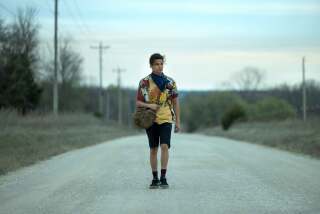CULTURE : Alaska TV Show Plugs Into Life in Native Villages : ‘Heartbeat Alaska’ attracts a huge audience with a homespun mix of news and amateur videos.
- Share via
ANCHORAGE — It’s 6:30 on Sunday night, and in more than 200 villages across Alaska, people are settling in to watch the most popular TV program in the bush.
The picture shows indigenous hunters getting ready for their spring pursuit of bowhead whales in the Arctic Ocean. A middle-aged Inupiat man talks to the camera as he helps stretch rubbery seal hide over a wooden boat frame.
The next segment reports on the only Eskimo dog-musher to run in this year’s 1,100-mile Iditarod Trail Sled Dog Race. That’s followed by news from Toksook Bay--homemade video from a meeting of Yupik-speaking elders talking about how to keep their traditional culture alive in the age of computers and TV.
It’s a typical edition of “Heartbeat Alaska”--part home movies, part news magazine, part community meeting for a community twice the size of Texas.
It’s the only statewide TV program owned and produced by indigenous Alaskans, and viewers tune in by the tens of thousands every week.
The show’s homespun look at everyday village life has begun attracting an audience outside Alaska as well.
Television has been around village Alaska for 20 years or so, ever since the state government used part of its newfound oil wealth in the 1970s to set up a satellite channel to beam everything from “Dallas” to “Sesame Street” to the state’s tiny communities.
Today, people in many native villages--places with names like Klawock and Kaktovik and Kwigillingok--pass the winters watching HBO, CNN and ESPN. Village children are as likely to know the latest Mariah Carey hit as the traditional songs of their grandparents.
While TV has become a link to the modern world, many villagers say they think that it has contributed to the erosion of native languages and cultures. Until now, native children turning on the TV had not been able to see their own world--or anything even resembling it.
All of which explains why the friendly, non-show biz feel of “Heartbeat Alaska” has struck a chord with a lot of people in the villages. The home videos might be shaky and the sound muffled. The hosts have been known to sit behind their desk munching on wild berries, dried seal meat and smoked salmon sent in by viewers. It’s all part of the appeal.
“We’re not trying to be sexy or hot or trendy,” said Jeanie Greene, the program’s creator, producer and main host. “We don’t have to sit here and be the final authority or look a certain way. We’re just showing what it’s like out there and listening to people and allowing native people to get their own stories on television. It’s interesting. No one’s ever done it before.”
The 30-minute, weekly program is the vision of Greene, a 41-year-old Inupiat with a degree in theater who spent 10 years working in local television.
It started as a twice-a-week segment on an Anchorage newscast. About two years ago, Greene decided to break away and form her own production company. Using secondhand equipment in the living room of her apartment, she and a cousin--her engineer/cameraman--started putting together “Heartbeat.”
The state satellite channel picked it up, and the show took off. Today, it also airs on commercial stations in Anchorage and Fairbanks, across five time zones on the Television Northern Canada network, on a station in Nuuk, Greenland, and on the Navajo Nation channel in Window Rock, Ariz. The program has fans in the Russian Far East, who pick it up from the Alaska satellite.
A typical episode features a story by Greene on, say, proposed cuts in funding for rural Alaska college campuses or the difficulty native dog-mushers have finding sponsors for competitive races. There’s a weekly roundup of native news from across North America and reports sent in by professional TV studios in two of the larger Alaska villages. The show tackles tough topics, such as village alcoholism, suicide and the lack of jobs.
But it’s heart and soul are the videos sent in by viewers, whom Greene uses like an army of correspondents.
“A lot of what’s on TV is pretty ridiculous,” said Shirley Goldy, a Inupiat social worker from the village of Kotzebue. “This program shows people, kids especially, it shows them it’s OK to be native. . . . I think it’s helping people get their respect back.”
More to Read
Sign up for Essential California
The most important California stories and recommendations in your inbox every morning.
You may occasionally receive promotional content from the Los Angeles Times.










